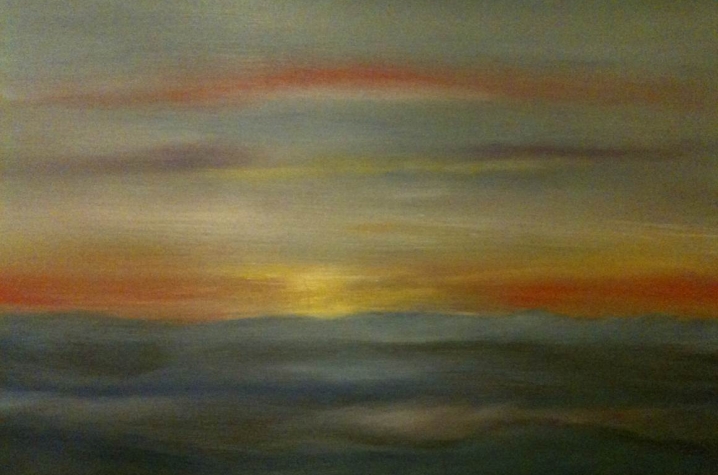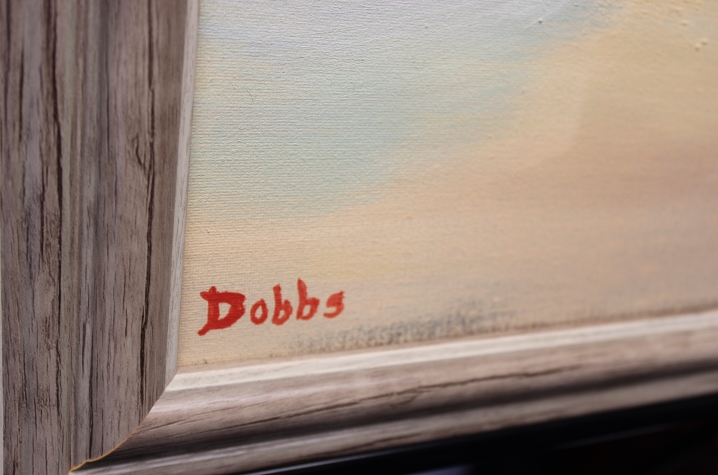Art Meets Science: A Profile on Dr. Michael Dobbs
LEXINGTON, Ky. (Jan. 24, 2014) -- One doesn't expect that the chief of neurology would have a lot of downtime. But, as Dr. Michael Dobbs explains, working as a neurologist at UK HealthCare can sometimes mean just that.
"KNI (Kentucky Neuroscience Institute) has unsurpassed expertise to treat stroke patients, and Kentucky has one of the highest rates of stroke occurrence in the nation," says Dobbs. "So I have spent more nights than I care to count consulting with physicians around the state, trying to determine whether their patients need the level of care that KNI provides. Sometimes that means I stay awake waiting for phone calls."
Dobbs admits that he hates to be idle. So, what to do with that middle-of-the-night free time?
He paints.
As a child, Dobbs loved to draw, but the rigors of a medical school education, a family, and a stint at Harvard University to earn a master's degree in public health foreclosed the opportunity to pursue his hobby.
While his primary interest was drawing, painting had always intrigued him. "I thought paints would be too messy, however, so I stuck with drawing," says Dobbs.
But one day in 2010, helping his daughter Catherine shop for her school art supplies, he spied a set of oil paints on clearance. "I thought, hey, it's only $15, not much to lose there, and I bought it on a lark."
He chuckles as he shows his first attempt -- a portrait of Catherine. "I don't consider it a failure, but it wasn't the best," he laughs. "But I still kept it. I like to use it to remind myself of the progress I've made."
Dissatisfied with his first foray, Dobbs began to study art books -- but not Painting for Dummies. "You know those coffee table books about art? It turns out they have a lot of useful commentary that can inform a painter as they practice and improve their skill," he explains. "It helped make my second attempt passable."
While portraiture fascinated him, Dobbs struggled with the time investment required for such detailed work, and so he moved on to study landscapes. He explains that they take less time to finish -- as little as 60 minutes -- although he admits that he must sometimes return to a painting before he's satisfied. "One of my paintings, "Sunrise, Blue Ridge Mountains," took four or five extra rounds to finish, because I didn't like how I portrayed the light reflecting off a mountainside."
When Dobbs' work began to generate interest, a friend put him in touch with the National Brain Tumor Foundation, who placed his "Sunrise, Blue Ridge Mountains" in their annual fundraising auction. Dobbs remembers clearly his reaction to the call confirming his first ever sale.
"It was a very personal experience. I still wonder -- who bought it? Where do they live? A part of me was launched into the world, and I will likely never see it again."
The fact that UK has "officially" embraced the concept of the arts in healing through the Arts in HealthCare Program is a big deal to Dobbs, who feels the art displayed throughout the medical center enriches the experience for patients, their families, faculty and staff.
"I had a stroke patient few years ago whose family wheeled her around the hospital to look at the art," Dr. Dobbs recalls. "It clearly calmed her, and she even told her friends that she was living in a museum."
"Art in an otherwise institutional setting allows patients, family, faculty and staff to pause and take a breather from a stressful situation."
Dobbs' commitment to the Arts in HealthCare extends beyond mere admiration for the program. "I wanted to be a part of this awesome new enterprise, so I contacted Jacquie (Hamilton; Director of the UK Arts in HealthCare Program) and offered to do an exhibition of my work," he says. The proceeds from the sale of his art at the show, which is tentatively scheduled for the spring, will benefit the Arts in HealthCare program.
Dobbs believes that art informs his medical practice and vice-versa. "I like to paint loosely and without too many details," he says. "As a neurologist, I know that the viewer’s brain will fill in the details subconsciously, and I believe that allows them to contribute a more personal interpretation -- and perhaps a deeper meaning -- to the art."
This scientist/painter challenges the prevailing wisdom that science is concrete, while art is more fluid. He asserts that they are more similar than different.
"Science and art have undeniable parallels," he says. "The interpretation of both depends on the viewer’s perspective. Neither necessarily represents fundamental truth in nature. Both science and art can be used to find truths, but both must be interpreted to achieve significance."








